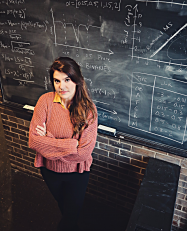Welcome to the Astrobites coverage of the 2024 April APS Meeting! We will report on highlights from each day here, from APS Plenaries to DAP (Division of Astrophysics) invited sessions to graduate student research talks. If you’d like to see more timely updates during the day, we encourage you to search the #aprilAPS hashtag on twitter. This is the final day’s coverage of April APS 2024, you can find the other days here: day 1, day 2, and day 3!
LeRoy Apker Award Session
The LeRoy Apker Award is an award to recognize outstanding undergraduate research. There are two awards presented per year, and includes $5,000 for the recipient, $5,000 to support undergraduate research presented to their undergraduate institution’s physics department, a certificate recognizing their accomplishment, and an invitation to give an invited talk at APS (with travel reimbursement provided). One of the 2024 winners for this award is Cailin Plunkett, “for the development of a novel method to compute survey sensitivity to accreting protoplanets.”

In her talk, Cailin seeks to understand how planets form by studying the formation of protoplanets. These objects are not the easiest to observe – they are a relatively short part of the planet’s life, and are often embedded in interstellar disks that outshine these objects. But despite the difficulty, a dedicated survey called GAPlanetS has found 5 protoplanet candidates. With these first few candidates in mind, Cailin seeks to understand the sensitivity we have to these objects, and which ones we might be missing. This is often called completeness – we know there are missing objects in our sample, since (for example) we need them to be a particular brightness level before we see the objects. So, what mechanism could be forming these protoplanets, and which protoplanets are missing from our observations?
She starts by taking the object’s physical characteristics (their mass and semimajor axis of their orbit) and translating them into what we’ll actually observe: their brightness and separation from their star. Their brightness is affected by how these planets form (like planets or like stars), and how they collect (accrete) material onto their surface. Then she can simulate populations of protoplanets, and see which ones we can observe with current observatories. With her calculation of the completeness, we get the first estimates of protoplanet formation rates, but with a small sample size there is still large statistical uncertainty. But, this lays the groundwork for future understanding of protoplanets, and with more surveys searching for these objects, we can learn more about the formation of protoplanets.
Cailin’s talk focused on how planets form, but the next two talks discussed how planets are digested by their host stars. Next in the session was Dr. Melinda Soares-Furtado, with her talk “Devoured Worlds: The Observational Signatures of Planetary Engulfment Events.”
Planets being consumed by their star isn’t a rare phenomenon: Dr. Soares-Furtado says that about 1/3 of the exoplanets we know of will eventually be consumed by their star. But how does the engulfment of a planet affect a star 1000 times its size? There are actually fingerprints of the planet which we can see in the star’s spectrum. She says that in certain cases the star will be engulfed inside the convection zone of the star, and in this case we could see some distinct imprints: a temporary change in the brightness or color of the star, changes in the star’s rotation, or even a change in the chemistry of the star’s spectrum.

One specific case is lithium: most of the lithium in the original star will have burned off, but a collision with a planet could increase the amount of lithium in the spectrum. In the case of a star that is 1.4-1.6 solar masses that consumes a gas giant (like Jupiter), we could see this very distinct feature in the spectrum.
The next speaker, graduate student Ricardo Yarza, continued the discussion of what happens when a planet is engulfed by its star, by modeling the process the planet is undergoing inside the star. These simulations can be incredibly computationally expensive, but by focusing in to the region just around the planet, the simulations are able to consider all three dimensions. Depending on the radius of the planet compared to the radius of the star, the simulation behaves differently, but can give a full picture of what is happening.

When a planet is engulfed, it can increase the brightness of the star temporarily in a type of transient event similar to a luminous red nova (which is the collision of two stars). One such transient event has been observed by the Zwicky Transient Facility (ZTF), which looked similar to a stellar merger, but less bright and with a smaller object, pointing to one of these planetary engulfment events. Ricardo studies events like the one detected by ZTF, finding that the star initially “grazes” the star, but then hits a turning point and plunges into the star.
Featured Image Credit: NASA, ESA, CSA/Joseph DePasquale (STScI), Anton M. Koekemoer (STScI)
Edited by: Storm Colloms, Huei Sears


